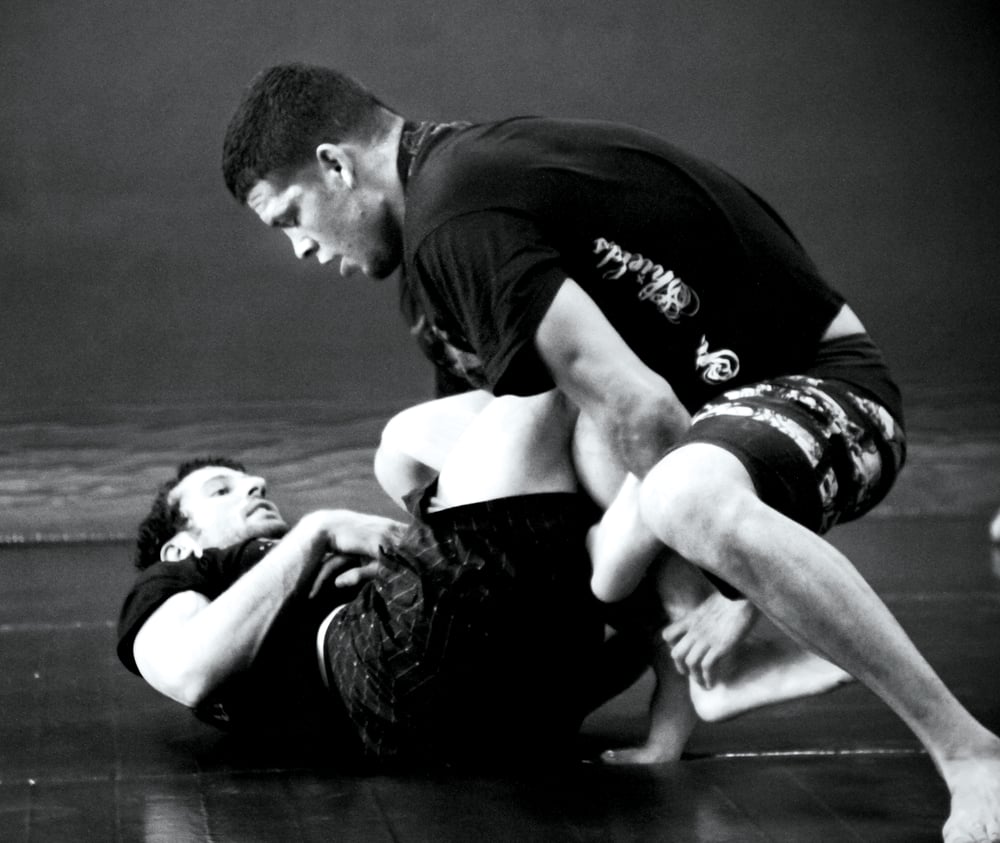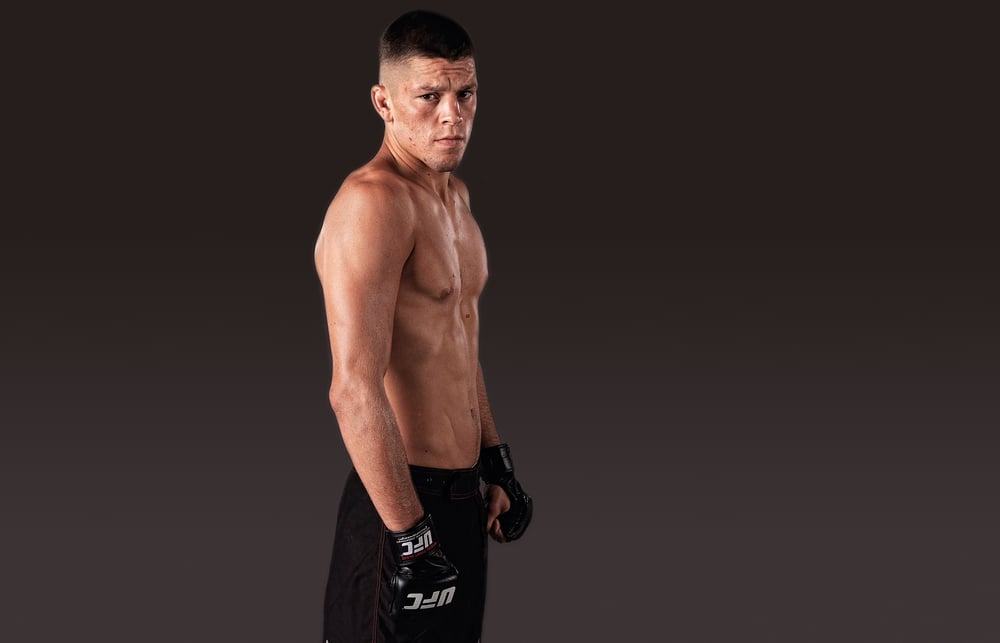
Issue 087
April 2012
How home boxing bouts honed Nate Diaz into one of the UFC’s 155lb best
NEED TO KNOW
NAME: NATE DIAZ
AGE: 26
STARTED: 2004
TEAM: Cesar Gracie jiu-jitsu
DIVISION: Lightweight
STYLE: Boxing, jiu-jitsu
RECORD: 15-7
Your best bet is to keep boxing gloves around. First and foremost it’s a safety measure. Padding protects the knuckles from breaking upon impact on an adversary’s skull. Secondly, it’s a quick solution. No conflicts go unresolved with a pair of leather fists to throw. Lastly, and most importantly, gloves are education tools. They teach the art and brutality lesson that serves as an all-too-apt metaphor for life’s most refined points. Which are ironically some of its most animalistic.
Stockton, California, home to UFC lightweight Nathan Diaz, and his older welterweight brother Nick, is a fighting town. It looks like it did in anti-establishment 1967 classic Cool Hand Luke starring Paul Newman, where it doubles as the South in the late ’40s. Stockton would feel totally left behind – totally defeated – by the recession if not for the Golden State weather and local pride. Pride in perseverance, self-preservation really. The Diaz brothers are known for the slick submissions they attribute to Cesar Gracie Jiu-Jitsu and their 209 telephone area code. But it’s their high-volume, damage-accelerating boxing that has captured the minds of mixed martial arts fans in recent years.
“I remember my dad came home with boxing gloves when we were little kids – second, first grade – brought out boxing gloves and mouthpieces, molded ‘em up and was like, ‘Alright, box,’” Nate recalls to Fighters Only inside the media-frenzied Mandalay Bay Events Center, Las Vegas. “[Nick] punched me in the nose, blood was everywhere. I was crying. Ever since then, I was like, ‘Man, we need boxing gloves here at all times.’”
Lucky there were mouthpieces. That wasn’t always the case. Age doesn’t protect from the real tough lessons someone, somewhere down the line will teach. Better to learn them from one’s tribe. Preparation is the surest route away from defeat. Front yard. Family parties. Get togethers meant there was always a time and a place for fights.
“Nick would box anyone who would come over,” he says. “We had a punching bag hanging from the tree in our front yard. It was kind of crazy if you think back on it, but when we were kids, it was: put mats in the room, put a punching bag in the front yard, get some boxing gloves.”
The obsessive phase; every fighter has it. Discover mixed martial arts then watch and train everything. The Diaz boys expended their restless youthful energy during the long, dry Stockton days the only way they knew how: training. In that way, nothing’s changed now that both are renowned UFC prizefighters.

Special strides early in training separates the haves from the have-nots. The crop that becomes contenders or champions signal that through creativity or by catching submissions early and often.
“I didn’t really see that in Nathan to be honest with you. He didn’t have the hard head like Nick did,” says Cesar Gracie, who has been training them for a decade. “He followed his brother with sheer determination to be a great fighter. He was determined to be great and that’s what he became.”
While everyone else in the town was out to fight, they were learning the sport of fighting. Most 14-year-olds flex in the mirror looking for imaginary muscles. Nathan Diaz was instilling his with the memory needed to pull off armbars and triangle chokes.
“When I was 21, I had already been training for six or seven years. It helped me grow up a little... I was always the youngest kid in the gym. Being a white belt trying not to act up around people,” recalls Diaz. “When I went on The Ultimate Fighter [season five], there were 30-year-old, 28-year-old guys and I was just a kid, straight up in the house. People were obnoxious. Man, these people must not be at a real gym with real people. If I went into my gym acting like that, it wouldn’t work out too well.”
It’s been the same way for Diaz since his front yard days. Nick, two years Nathan’s elder, noticed his brother’s listless use of time. Their house had evolved into fertile training grounds for Nick, who plastered fighting posters all over his walls and matted the floors of his room for jiu-jitsu’s sake. Too many friends were visiting to train. Before Nathan knew it, he didn’t have a choice because that was the only activity available. Home mats meant home grappling tournaments. In the Diaz brothers’ world, to act right is to train right, and eventually fight right.
When Nick got his blue belt, all the Royce Gracie video-cassette tapes and time he spent away suddenly made sense to Nathan.
“I seen him tapping out the biggest guys, big wrestlers, strong tough guys, I was like, ‘That’s a rap for me.’ I went to school telling people how a blue belt would take out anybody,” says the 26-year-old. “I was sold. All you gotta do is be a blue belt and you can take on whoever you want.”
Nick’s friend Paul was a consistent training partner who brought his little brother Russell over, prompting Nick to offer up Nathan as a sparring partner. Eventually, this dynamic would evolve into training with future champions Jake Shields and Gilbert Melendez – Jake versus Nick and Nathan against Gilbert – as the competitive core of the Cesar Gracie fight team opposite the Diaz bros.
“These guys wanted to be fighters. That’s their higher education,” asserts Gracie. “Get their belts in jiu-jitsu, get their boxing in, do The Ultimate Fighter for Nathan for example. It’s been a good education, definitely.”
The obsessive phase: the posters Nathan had of Steve Young and Jerry Rice disappeared along with his San Francisco 49ers fandom. The Chicago Bulls and Michael Jordan no longer adorned his wall either. Pre-dating YouTube, he got hold of all the tapes he could and when at friends’ houses, searched Google video for clips of Renzo Gracie and Matt Serra, his new sports heroes. A multiple-sport athlete – soccer, football, basketball and swimming – Nathan let grappling take over his life.
As if the fighting mentality wasn’t strong enough in Diaz, Gracie’s gym bred jiu-jitsu fighters, not jiu-jitsu players. Gracie challenges occurred center mat every session between Diaz and fellow aspiring blue belts until he was ready to earn one. This test of technique was more a test of wills, the designated gameness evaluation.
“Then I realized, it’s pretty realistic, if you want your blue belt, purple belt, brown belt, you gotta get it. You don’t just get to get it,” says Diaz. “You gotta go get it. Competition has been going on my whole life, even in the gym still.”

It’s no surprise Diaz has evolved into an anywhere-anytime-any-weight fighter like his older brother. Benefits of higher education were never available to the Diaz boys; however, they firmly believe their diplomas have been in the ring and on the mats. After all, Nick made his professional debut at 18 years old and Nathan at 19.
Nathan recalls watching the UFC’s reality show for the first time with his brother and dismissing it for its ridiculousness. It took some convincing to get the younger Diaz to enter season five’s TV fighting tournament. Three submissions later, the youngest fighter in the house during season five won the live season finale as the inaugural lightweight victor. Uncomfortable with the process at the time, Diaz credits it as a crude introduction to the UFC, one he now appreciates.
“These guys were fighting so young that they had to learn in the cage,” explains Gracie. “He’s had to keep up with him because Nick is gonna go round after round and he expects the same thing from his brother.”
Nick goes out of his way to point out despite the championships he’s won, Nathan will be – or perhaps is – the better fighter. Five ‘Fight of the Night’ honors and three ‘Submission of the Night’ awards in his 15 Octagon appearances position Nathan to prove big bro’ right. It’s a compliment he handles with humility and reverence. Nick, in true big brother fashion, paved the road for Nathan. Making any endeavor easier is a plus, but to do so for fighting, to prepare Nathan for all the love and hate associated with high-profile UFC fighters in addition to the rugged training regimens allows him to live up to Nick’s expectations.
“The whole MMA thing, Nick has so much experience that he can show a guy like Nathan so much,” says Gracie. “Nick has learned so much in fighting, in the fights he’s won and lost, so he can pass that experience to Nathan, whereas Nick didn’t have that benefit.”
One of the most polarizing points of the Diaz bros has been their signature double-bird salute. For all the highlights of Nick defiantly taunting, Nathan scored the crowning 209 achievement in Colorado in 2008 when he submitted Kurt Pellegrino in a second-round comeback victory via triangle choke, complete with celebratory middle fingers in the air mid-tapout and resulting ‘Submission of the Night’ honors. The gesture remains a staple of the Diaz reputation. To them, this is not a gentlemanly sport.
“It is a fight. Where I came from, you’re here to fight, you’re not friends,” says Diaz. “It’s not a sport.”
Of course, mixed martial arts is a sport, he backtracks, but the sporting aspect, the athletics, all the elements that comprise it, are secondary to the fight. Fights are for survival and that’s exactly how the Diaz brothers have approached it. There are no points on the board, just damage busting the blood vessels around the eyes and limbs torqued to breaking points. They don’t necessarily love to fight as much as they respect its dangers.
The raw competitive attitude of the Diaz brothers contrasted by their shy and polite personality outside the cage became something special to Gracie: the ideal mix of coachable athletes with natural fighting spirit. Where they are now is something he envisioned from the beginning with these unique born-and-bred fighters.
“It took a long time and there were the naysayers, but you’ve got guys like GSP (Georges St Pierre) admitting that Nick is the best boxer in all of MMA,” says Gracie. “Nathan already has equal boxing, if not better than Nick’s right now. It’s high-volume punches. As far as technically, he’s better at it.”
It’s hard not to wonder if somewhere in any rough-and-tumble American town two brothers have a punching bag in their front yard, mats in the house – complete with Diaz brothers posters the way Nick had posters of MMA fighters from the turn of the millennium – and boxing gloves on hand at all times. Nathan greets the idea of a fan with Diaz brother’s posters on their wall with indifference.
The love from fans doesn’t go unnoticed though. He strolls through Mandalay signing autographs and taking photos with the entire first row while Nick handles media. Being hated by fans is just part of the game too he insists – it’s not just the Diaz brothers; it’s all UFC fighters.
“They think it’s pretty cool,” he says, not specifying whether it’s the cheers or jeers. “Think whatever you want, it’s cool that you got the poster up. It’s probably good that we got posters like those guys.”
THE HATE ISSUE
NATE DIAZ / DONALD CERRONE
“[Cerrone] made it up, trying to make me a bully. I walk the other way when I see him; he’s in the same division as me”










